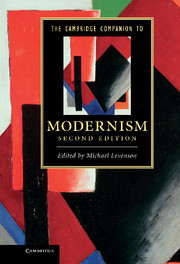Book contents
- Frontmatter
- Introduction
- 1 The metaphysics of Modernism
- 2 The cultural economy of Modernism
- 3 The Modernist novel
- 4 Modern poetry
- 5 Modernism in drama
- 6 Modernism and the politics of culture
- 7 Modernism and religion
- 8 Modernism and mass culture
- 9 Modernism and gender
- 10 Musical motives in Modernism
- 11 Modernism and the visual arts
- 12 Modernism and film
- 13 Modernism and colonialism
- Further reading
- Index
13 - Modernism and colonialism
Published online by Cambridge University Press: 28 September 2011
- Frontmatter
- Introduction
- 1 The metaphysics of Modernism
- 2 The cultural economy of Modernism
- 3 The Modernist novel
- 4 Modern poetry
- 5 Modernism in drama
- 6 Modernism and the politics of culture
- 7 Modernism and religion
- 8 Modernism and mass culture
- 9 Modernism and gender
- 10 Musical motives in Modernism
- 11 Modernism and the visual arts
- 12 Modernism and film
- 13 Modernism and colonialism
- Further reading
- Index
Summary
Interpretations of Modernism current in the academy still tend to assume a long-dominant Anglo-American or Euro-American axis, despite the fact that criticism in recent years has begun to ask new questions as regards the transnational makeup of early-twentieth-century literature and art. Moreover, although Modernism evidently involved a series of movements that were animated by, and shaped within, inter- and transnational arenas, Modernism’s methodological and critical coordinates by and large remain transatlantic. The cross-cultural and cross-national exchanges that took place between artists, and the various cross-border journeys they undertook, all centrally formative to what we now understand to be Modernism, are perceived to be in the main exchanges and journeys between Britain, the rest of Europe, and America. Even Richard Begam and Michael Valdez Moses’s Modernism and Colonialism (2007), a path-breaking collection investigating how "the modernist revolution can be understood as a critical and artistic engagement with the...European quest for empire," ultimately circumscribes the investigation it wishes to pursue by focusing, the introduction emphasizes, on "traditional" Modernism. Taking a different direction, this chapter proposes that the shaping of Modernism by a colonial geopolitics can be persuasively demonstrated by setting its canonical figures - Eliot, Woolf, Joyce, Yeats - in relation to expanded cosmopolitan and constellated colonial contexts, and examining the cultural and aesthetic contours of these.
- Type
- Chapter
- Information
- The Cambridge Companion to Modernism , pp. 284 - 300Publisher: Cambridge University PressPrint publication year: 2011
- 4
- Cited by

